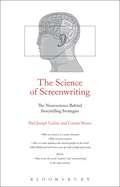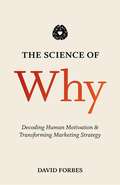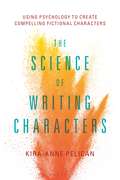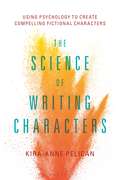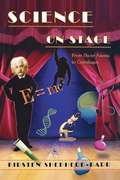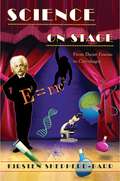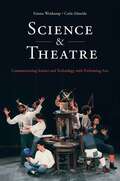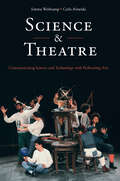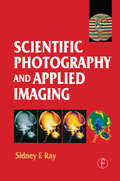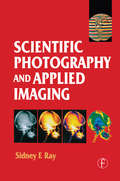- Table View
- List View
The Science of Paintings
by W.Stanley Jr. Taft James W. MayerThe physics and materials science behind paintings: the pigments, binders, canvas, and varnish that go into making a painting appear the way it does. The text discusses the physical principles behind the colors seen and how these change with illumination, the various types of paint and binders used in both old and modern paintings, and the optics and microscopic structure of paint films. Chapters on dating, binders, and dendochronology have been contributed by experts in the respective fields.
The Science of Screenwriting: The Neuroscience Behind Storytelling Strategies
by Paul Joseph Gulino Connie ShearsIn a world awash in screenwriting books, The Science of Screenwriting provides an alternative approach that will help the aspiring screenwriter navigate this mass of often contradictory advice: exploring the science behind storytelling strategies. Paul Gulino, author of the best-selling Screenwriting: The Sequence Approach, and Connie Shears, a noted cognitive psychologist, build, chapter-by-chapter, an understanding of the human perceptual/cognitive processes, from the functions of our eyes and ears bringing real world information into our brains, to the intricate networks within our brains connecting our decisions and emotions. They draw on a variety of examples from film and television -- The Social Network, Silver Linings Playbook and Breaking Bad -- to show how the human perceptual process is reflected in the storytelling strategies of these filmmakers. They conclude with a detailed analysis of one of the most successful and influential films of all time, Star Wars, to discover just how it had the effect that it had.
The Science of Screenwriting: The Neuroscience Behind Storytelling Strategies
by Paul Joseph Gulino Connie ShearsIn a world awash in screenwriting books, The Science of Screenwriting provides an alternative approach that will help the aspiring screenwriter navigate this mass of often contradictory advice: exploring the science behind storytelling strategies. Paul Gulino, author of the best-selling Screenwriting: The Sequence Approach, and Connie Shears, a noted cognitive psychologist, build, chapter-by-chapter, an understanding of the human perceptual/cognitive processes, from the functions of our eyes and ears bringing real world information into our brains, to the intricate networks within our brains connecting our decisions and emotions. They draw on a variety of examples from film and television -- The Social Network, Silver Linings Playbook and Breaking Bad -- to show how the human perceptual process is reflected in the storytelling strategies of these filmmakers. They conclude with a detailed analysis of one of the most successful and influential films of all time, Star Wars, to discover just how it had the effect that it had.
The Science of Why: Decoding Human Motivation and Transforming Marketing Strategy
by D. ForbesIn this groundbreaking book, author David Forbes explains human motivation and provides ways that marketers can effectively reach the consumer. The book uses decades of psychology research and the author's own tool, the Forbes Matrix that identifies, organizes, and explains the nine core motivations.
The Science of Writing Characters: Using Psychology to Create Compelling Fictional Characters
by Kira-Anne PelicanThe Science of Writing Characters is a comprehensive handbook to help writers create compelling and psychologically-credible characters that come to life on the page. Drawing on the latest psychological theory and research, ranging from personality theory to evolutionary science, the book equips screenwriters and novelists with all the techniques they need to build complex, dimensional characters from the bottom up. Writers learn how to create rounded characters using the 'Big Five' dimensions of personality and then are shown how these personality traits shape action, relationships and dialogue. Throughout The Science of Writing Characters, psychological theories and research are translated into handy practical tips, which are illustrated through examples of characters in action in well-known films, television series and novels, ranging from Three Billboards Outside Ebbing Missouri and Game of Thrones to The Bonfire of the Vanities and The Goldfinch. This very practical approach makes the book an engaging and accessible companion guide for all writers who want to better understand how they can make memorable characters with the potential for global appeal.
The Science of Writing Characters: Using Psychology to Create Compelling Fictional Characters
by Kira-Anne PelicanThe Science of Writing Characters is a comprehensive handbook to help writers create compelling and psychologically-credible characters that come to life on the page. Drawing on the latest psychological theory and research, ranging from personality theory to evolutionary science, the book equips screenwriters and novelists with all the techniques they need to build complex, dimensional characters from the bottom up. Writers learn how to create rounded characters using the 'Big Five' dimensions of personality and then are shown how these personality traits shape action, relationships and dialogue. Throughout The Science of Writing Characters, psychological theories and research are translated into handy practical tips, which are illustrated through examples of characters in action in well-known films, television series and novels, ranging from Three Billboards Outside Ebbing Missouri and Game of Thrones to The Bonfire of the Vanities and The Goldfinch. This very practical approach makes the book an engaging and accessible companion guide for all writers who want to better understand how they can make memorable characters with the potential for global appeal.
Science on American Television: A History
by Marcel Chotkowski LaFolletteAs television emerged as a major cultural and economic force, many imagined that the medium would enhance civic education for topics like science. And, indeed, television soon offered a breathtaking banquet of scientific images and ideas—both factual and fictional. Mr. Wizard performed experiments with milk bottles. Viewers watched live coverage of solar eclipses and atomic bomb blasts. Television cameras followed astronauts to the moon, Carl Sagan through the Cosmos, and Jane Goodall into the jungle. Via electrons and embryos, blood testing and blasting caps, fictional Frankensteins and chatty Nobel laureates, television opened windows onto the world of science. But what promised to be a wonderful way of presenting science to huge audiences turned out to be a disappointment, argues historian Marcel Chotkowski LaFollette in Science on American Television. LaFollette narrates the history of science on television, from the 1940s to the turn of the twenty-first century, to demonstrate how disagreements between scientists and television executives inhibited the medium’s potential to engage in meaningful science education. In addition to examining the content of shows, she also explores audience and advertiser responses, the role of news in engaging the public in science, and the making of scientific celebrities. Lively and provocative, Science on American Television establishes a new approach to grappling with the popularization of science in the television age, when the medium’s ubiquity and influence shaped how science was presented and the scientific community had increasingly less control over what appeared on the air.
Science on American Television: A History
by Marcel Chotkowski LaFolletteAs television emerged as a major cultural and economic force, many imagined that the medium would enhance civic education for topics like science. And, indeed, television soon offered a breathtaking banquet of scientific images and ideas—both factual and fictional. Mr. Wizard performed experiments with milk bottles. Viewers watched live coverage of solar eclipses and atomic bomb blasts. Television cameras followed astronauts to the moon, Carl Sagan through the Cosmos, and Jane Goodall into the jungle. Via electrons and embryos, blood testing and blasting caps, fictional Frankensteins and chatty Nobel laureates, television opened windows onto the world of science. But what promised to be a wonderful way of presenting science to huge audiences turned out to be a disappointment, argues historian Marcel Chotkowski LaFollette in Science on American Television. LaFollette narrates the history of science on television, from the 1940s to the turn of the twenty-first century, to demonstrate how disagreements between scientists and television executives inhibited the medium’s potential to engage in meaningful science education. In addition to examining the content of shows, she also explores audience and advertiser responses, the role of news in engaging the public in science, and the making of scientific celebrities. Lively and provocative, Science on American Television establishes a new approach to grappling with the popularization of science in the television age, when the medium’s ubiquity and influence shaped how science was presented and the scientific community had increasingly less control over what appeared on the air.
Science on American Television: A History
by Marcel Chotkowski LaFolletteAs television emerged as a major cultural and economic force, many imagined that the medium would enhance civic education for topics like science. And, indeed, television soon offered a breathtaking banquet of scientific images and ideas—both factual and fictional. Mr. Wizard performed experiments with milk bottles. Viewers watched live coverage of solar eclipses and atomic bomb blasts. Television cameras followed astronauts to the moon, Carl Sagan through the Cosmos, and Jane Goodall into the jungle. Via electrons and embryos, blood testing and blasting caps, fictional Frankensteins and chatty Nobel laureates, television opened windows onto the world of science. But what promised to be a wonderful way of presenting science to huge audiences turned out to be a disappointment, argues historian Marcel Chotkowski LaFollette in Science on American Television. LaFollette narrates the history of science on television, from the 1940s to the turn of the twenty-first century, to demonstrate how disagreements between scientists and television executives inhibited the medium’s potential to engage in meaningful science education. In addition to examining the content of shows, she also explores audience and advertiser responses, the role of news in engaging the public in science, and the making of scientific celebrities. Lively and provocative, Science on American Television establishes a new approach to grappling with the popularization of science in the television age, when the medium’s ubiquity and influence shaped how science was presented and the scientific community had increasingly less control over what appeared on the air.
Science on American Television: A History
by Marcel Chotkowski LaFolletteAs television emerged as a major cultural and economic force, many imagined that the medium would enhance civic education for topics like science. And, indeed, television soon offered a breathtaking banquet of scientific images and ideas—both factual and fictional. Mr. Wizard performed experiments with milk bottles. Viewers watched live coverage of solar eclipses and atomic bomb blasts. Television cameras followed astronauts to the moon, Carl Sagan through the Cosmos, and Jane Goodall into the jungle. Via electrons and embryos, blood testing and blasting caps, fictional Frankensteins and chatty Nobel laureates, television opened windows onto the world of science. But what promised to be a wonderful way of presenting science to huge audiences turned out to be a disappointment, argues historian Marcel Chotkowski LaFollette in Science on American Television. LaFollette narrates the history of science on television, from the 1940s to the turn of the twenty-first century, to demonstrate how disagreements between scientists and television executives inhibited the medium’s potential to engage in meaningful science education. In addition to examining the content of shows, she also explores audience and advertiser responses, the role of news in engaging the public in science, and the making of scientific celebrities. Lively and provocative, Science on American Television establishes a new approach to grappling with the popularization of science in the television age, when the medium’s ubiquity and influence shaped how science was presented and the scientific community had increasingly less control over what appeared on the air.
Science on Screen and Paper: Media Cultures and Knowledge Production in Cold War Europe (Visual and Media Cultures of the Cold War and Beyond #2)
by Mariana Ivanova Juliane ScholzDuring the Cold War, scientific discoveries were adapted and critiqued in many different forms of media across a divided Europe. Now, more than 30 years since the end of the Cold War, Science on Screen and Paper explores the intersections between scientific research and media by drawing from media history, film studies, and the history of science. From public relations material to educational and science films, from children’s magazines to television broadcasts, the contributions in this collected volume seek to embrace medial differences and focus on intersectional themes and strategies for the representation of science.
Science on Screen and Paper: Media Cultures and Knowledge Production in Cold War Europe (Visual and Media Cultures of the Cold War and Beyond #2)
by Mariana Ivanova Juliane ScholzDuring the Cold War, scientific discoveries were adapted and critiqued in many different forms of media across a divided Europe. Now, more than 30 years since the end of the Cold War, Science on Screen and Paper explores the intersections between scientific research and media by drawing from media history, film studies, and the history of science. From public relations material to educational and science films, from children’s magazines to television broadcasts, the contributions in this collected volume seek to embrace medial differences and focus on intersectional themes and strategies for the representation of science.
Science on Screen and Paper: Media Cultures and Knowledge Production in Cold War Europe (Visual and Media Cultures of the Cold War and Beyond #2)
by Mariana Ivanova and Juliane ScholzDuring the Cold War, scientific discoveries were adapted and critiqued in many different forms of media across a divided Europe. Now, more than 30 years since the end of the Cold War, Science on Screen and Paper explores the intersections between scientific research and media by drawing from media history, film studies, and the history of science. From public relations material to educational and science films, from children’s magazines to television broadcasts, the contributions in this collected volume seek to embrace medial differences and focus on intersectional themes and strategies for the representation of science.
Science on Stage: From "Doctor Faustus" to "Copenhagen"
by Kirsten Shepherd-BarrScience on Stage is the first full-length study of the phenomenon of "science plays"--theatrical events that weave scientific content into the plot lines of the drama. The book investigates the tradition of science on the stage from the Renaissance to the present, focusing in particular on the current wave of science playwriting. Drawing on extensive interviews with playwrights and directors, Kirsten Shepherd-Barr discusses such works as Michael Frayn's Copenhagen and Tom Stoppard's Arcadia. She asks questions such as, What accounts for the surge of interest in putting science on the stage? What areas of science seem most popular with playwrights, and why? How has the tradition evolved throughout the centuries? What currents are defining it now? And what are some of the debates and controversies surrounding the use of science on stage? Organized by scientific themes, the book examines selected contemporary plays that represent a merging of theatrical form and scientific content--plays in which the science is literally enacted through the structure and performance of the play. Beginning with a discussion of Christopher Marlowe's Doctor Faustus, the book traces the history of how scientific ideas (quantum mechanics and fractals, for example) are dealt with in theatrical presentations. It discusses the relationship of science to society, the role of science in our lives, the complicated ethical considerations of science, and the accuracy of the portrayal of science in the dramatic context. The final chapter looks at some of the most recent and exciting developments in science playwriting that are taking the genre in innovative directions and challenging the audience's expectations of a science play. The book includes a comprehensive annotated list of four centuries of science plays, which will be useful for teachers, students, and general readers alike.
Science on Stage: From Doctor Faustus to Copenhagen (PDF)
by Kirsten Shepherd-BarrScience on Stage is the first full-length study of the phenomenon of "science plays"--theatrical events that weave scientific content into the plot lines of the drama. The book investigates the tradition of science on the stage from the Renaissance to the present, focusing in particular on the current wave of science playwriting. Drawing on extensive interviews with playwrights and directors, Kirsten Shepherd-Barr discusses such works as Michael Frayn's Copenhagen and Tom Stoppard's Arcadia. She asks questions such as, What accounts for the surge of interest in putting science on the stage? What areas of science seem most popular with playwrights, and why? How has the tradition evolved throughout the centuries? What currents are defining it now? And what are some of the debates and controversies surrounding the use of science on stage? Organized by scientific themes, the book examines selected contemporary plays that represent a merging of theatrical form and scientific content--plays in which the science is literally enacted through the structure and performance of the play. Beginning with a discussion of Christopher Marlowe's Doctor Faustus, the book traces the history of how scientific ideas (quantum mechanics and fractals, for example) are dealt with in theatrical presentations. It discusses the relationship of science to society, the role of science in our lives, the complicated ethical considerations of science, and the accuracy of the portrayal of science in the dramatic context. The final chapter looks at some of the most recent and exciting developments in science playwriting that are taking the genre in innovative directions and challenging the audience's expectations of a science play. The book includes a comprehensive annotated list of four centuries of science plays, which will be useful for teachers, students, and general readers alike.
Science, Technology and Culture: Cultural Studies Volume 12 Issue 3
by Ann BalsamoA special issue of the established journal 'Cultural Studies', devoted to the study of culture in scientific and technological systems.
Science, Technology and Culture: Cultural Studies Volume 12 Issue 3
by Anne BalsamoA special issue of the established journal 'Cultural Studies', devoted to the study of culture in scientific and technological systems.
Science & Theatre: Communicating Science and Technology with Performing Arts
by Emma Weitkamp Carla AlmeidaThere has been a significant growth in initiatives involving theatre, drama and performance within a science communication context. Yet there is little scholarship exploring this phenomenon from a science communication perspective. Weitkamp and Almeida draw on their distinct experiences with theatre in the context of science communication to delve into initiatives created through dialogue between the arts and the sciences for the purpose of public engagement. Entering into the space where museums, universities and research centres operate, as well as the space of theatre practitioners, they explore the richness and plurality of this universe, combining theory and practice, as well as presenting context, knowledge gaps and new data. Acknowledging that the place of drama, theatre and performance within science communication is one which is uniquely influenced by local cultural practices, discourses and expectations, the authors take a global perspective. Firstly by analysing data from an international survey of practitioners and secondly by curating a collection of case studies on science-theatre projects undertaken around the world. The chapters illustrate the diversity of forms and content that comprises contemporary science-theatre in this context and characterise theatre produced within the scope of science communication, placing it more precisely in the broader context of science-theatre.
Science & Theatre: Communicating Science and Technology with Performing Arts
by Emma Weitkamp Carla AlmeidaThere has been a significant growth in initiatives involving theatre, drama and performance within a science communication context. Yet there is little scholarship exploring this phenomenon from a science communication perspective. Weitkamp and Almeida draw on their distinct experiences with theatre in the context of science communication to delve into initiatives created through dialogue between the arts and the sciences for the purpose of public engagement. Entering into the space where museums, universities and research centres operate, as well as the space of theatre practitioners, they explore the richness and plurality of this universe, combining theory and practice, as well as presenting context, knowledge gaps and new data. Acknowledging that the place of drama, theatre and performance within science communication is one which is uniquely influenced by local cultural practices, discourses and expectations, the authors take a global perspective. Firstly by analysing data from an international survey of practitioners and secondly by curating a collection of case studies on science-theatre projects undertaken around the world. The chapters illustrate the diversity of forms and content that comprises contemporary science-theatre in this context and characterise theatre produced within the scope of science communication, placing it more precisely in the broader context of science-theatre.
Scientific Astrophotography: How Amateurs Can Generate and Use Professional Imaging Data (The Patrick Moore Practical Astronomy Series)
by Gerald R. HubbellScientific Astrophotography is intended for those amateur astronomers who are looking for new challenges, once they have mastered visual observing and the basic imaging of various astronomical objects. It will also be a useful reference for scientifically inclined observers who want to learn the fundamentals of astrophotography with a firm emphasis on the discipline of scientific imaging. This books is not about making beautiful astronomical images; it is about recording astronomical images that are scientifically rigorous and from which accurate data can be extracted. This book is unique in that it gives readers the skills necessary for obtaining excellent images for scientific purposes in a concise and procedurally oriented manner. This not only gets the reader used to a disciplined approach to imaging to maximize quality, but also to maximize the success (and minimize the frustration!) inherent in the pursuit of astrophotography. The knowledge and skills imparted to the reader of this handbook also provide an excellent basis for “beautiful picture” astrophotography! There is a wealth of information in this book – a distillation of ideas and data presented by a diverse set of sources and based on the most recent techniques, equipment, and data available to the amateur astronomer. There are also numerous practical exercises. Scientific Astrophotography is perfect for any amateur astronomer who wants to go beyond just astrophotography and actually contribute to the science of astronomy.
Scientific Computing and Cultural Heritage: Contributions in Computational Humanities (Contributions In Mathematical And Computational Sciences Ser.)
by Hans Georg Bock, Willi Jäger and Michael J. WincklerThe sheer computing power of modern information technology is changing the face of research not just in science, technology and mathematics, but in humanities and cultural studies too. Recent decades have seen a major shift both in attitudes and deployment of computers, which are now vital and highly effective tools in disciplines where they were once viewed as elaborate typewriters. This revealing volume details the vast array of computing applications that researchers in the humanities now have recourse to, including the dissemination of scholarly information through virtual ‘co-laboratories’, data retrieval, and the modeling of complex processes that contribute to our natural and cultural heritage. One key area covered in this book is the versatility of computers in presenting images and graphics, which is transforming the analysis of data sets and archaeological reconstructions alike. The papers published here are grouped into three broad categories that cover mathematical and computational methods, research developments in information systems, and a detailed portrayal of ongoing work on documenting, restoring and presenting cultural monuments including the temples in Pompeii and the Banteay Chhmar temples of the Angkorian period in present-day Cambodia. Originally presented at a research workshop in Heidelberg, Germany, they reflect the rapidly developing identity of computational humanities as an interdisciplinary field in its own right, as well as demonstrating the breadth of perspectives in this young and vibrant research area.
Scientific Investigation of Copies, Fakes and Forgeries
by Paul CraddockThe faking and forgery of works of art and antiquities is probably now more extensive than ever before. The frauds are aided by new technologies, from ink jet printers to epoxy resins, and driven by the astronomic prices realised on the global market. This book aims to provide a comprehensive survey of the subject over a wide range of materials, emphasising how the fakes and forgeries are produced and how they may be detected by technical and scientific examination. The subject is exemplified by numerous case studies, some turning out not to be as conclusive as is sometimes believed. The book is aimed at those likely to have a serious interest in these investigations, be they curator, collector, conservator or scientist. Paul Craddock has recently retired from the Department of Conservation, Documentation and Science at the British Museum, where he was a materials scientist.
Scientific Investigation of Copies, Fakes and Forgeries
by Paul CraddockThe faking and forgery of works of art and antiquities is probably now more extensive than ever before. The frauds are aided by new technologies, from ink jet printers to epoxy resins, and driven by the astronomic prices realised on the global market. This book aims to provide a comprehensive survey of the subject over a wide range of materials, emphasising how the fakes and forgeries are produced and how they may be detected by technical and scientific examination. The subject is exemplified by numerous case studies, some turning out not to be as conclusive as is sometimes believed. The book is aimed at those likely to have a serious interest in these investigations, be they curator, collector, conservator or scientist. Paul Craddock has recently retired from the Department of Conservation, Documentation and Science at the British Museum, where he was a materials scientist.
Scientific Photography and Applied Imaging
by Sidney RayWINNER OF THE 2001 KRASZNA-KRAUSZ PHOTOGRAPHY BOOK AWARD (Technical Photography category)The only definitive book to fully encompass the use of photography and imaging as tools in science, technology and medicine. It describes in one single volume the basic theory, techniques, materials, special equipment and applications for a wide variety of uses of photography, including: close up photography and photomacrography to spectral recording, surveillance systems, radiography and micro-imaging. This extensively illustrated photography 'bible' contains all the information you need, whether you are a scientist wishing to use photography for a specialist application, a professional needing to extend technical expertise, or a student wanting to broaden your knowledge of the applications of photography.The contents are arranged in three sections:· General Section, detailing the elements of the image capture process· Major Applications, describing the major applications of imaging · Specialist Applications, presenting an eclectic selection of more specialised but increasingly important applicationsEach subject is introduced with an outline of its development and contemporary importance, followed by explanations of essential theory and an overview of techniques and equipment. Mathematics is only used where necessary. Numerous applications and case studies are described. Comprehensive bibliographies and references are provided for further study.
Scientific Photography and Applied Imaging
by Sidney RayWINNER OF THE 2001 KRASZNA-KRAUSZ PHOTOGRAPHY BOOK AWARD (Technical Photography category)The only definitive book to fully encompass the use of photography and imaging as tools in science, technology and medicine. It describes in one single volume the basic theory, techniques, materials, special equipment and applications for a wide variety of uses of photography, including: close up photography and photomacrography to spectral recording, surveillance systems, radiography and micro-imaging. This extensively illustrated photography 'bible' contains all the information you need, whether you are a scientist wishing to use photography for a specialist application, a professional needing to extend technical expertise, or a student wanting to broaden your knowledge of the applications of photography.The contents are arranged in three sections:· General Section, detailing the elements of the image capture process· Major Applications, describing the major applications of imaging · Specialist Applications, presenting an eclectic selection of more specialised but increasingly important applicationsEach subject is introduced with an outline of its development and contemporary importance, followed by explanations of essential theory and an overview of techniques and equipment. Mathematics is only used where necessary. Numerous applications and case studies are described. Comprehensive bibliographies and references are provided for further study.

